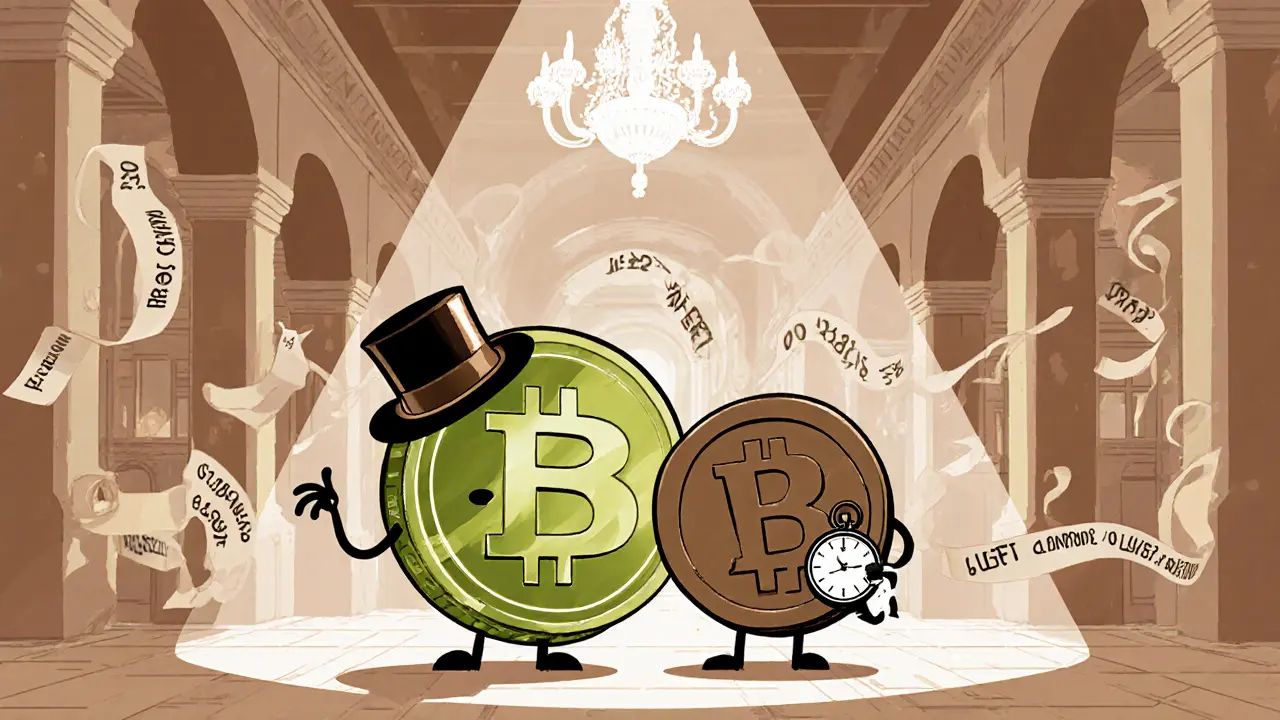WeFi Token Price Comparison Tool
Current Token Information
WFI Token
WEFI Token
Select a token above to see detailed information.
Key Takeaways
- WeFi aims to blend traditional banking services with a decentralized crypto platform.
- Two token symbols appear in the market - WFI (around $0.82) and WEFI (around $0.06), reflecting data inconsistencies.
- The ecosystem includes custodial & non‑custodial wallets, payment cards, AI‑driven compliance and Zero‑Knowledge Proof technology.
- Pricing varies across exchanges; investors should verify contract addresses before trading.
- Roadmap details are scarce, so risk assessment should focus on transparency and regulatory status.
What is WeFi?
WeFi is a decentralized financial ecosystem that markets itself as the world’s first “Deobank.” It aims to merge everyday banking conveniences - like payment cards and ATM withdrawals - with blockchain‑based services such as crypto wallets and token‑driven rewards. The project’s official site (wefi.co) positions the platform as a bridge between fiat and crypto, promising users the ability to hold, spend and earn on a single network.
The team behind WeFi reportedly includes former executives from Tether, Wise, Bitpanda and Binance. While names are not publicly listed, those affiliations are used to convey industry credibility.
Token Symbols and Market Data
One of the most confusing aspects of the project is the dual token notation. Some trackers list the token as WFI, while others use WEFI. The price gap is stark:
- On platforms like BitMart and BingX, WFI trades around $0.81‑$0.83 with daily volumes exceeding $2million.
- CoinGecko’s data for WEFI shows a price near $0.06, a circulating supply of 42million tokens and a market cap of roughly $6.5million.
These discrepancies suggest either separate contracts or reporting errors. Before buying, confirm the contract address on the exchange and cross‑check with the official WeFi documentation.
Core Components of the WeFi Ecosystem
The platform is built around several interconnected services:
- Custodial wallets - Managed by WeFi, these wallets store crypto on behalf of users, simplifying onboarding for newcomers.
- Non‑custodial wallets - Give users full private‑key control, aligning with DeFi principles.
- Crypto‑collateralized payment cards - Physical or virtual cards that draw funds from a user’s crypto balance, enabling everyday purchases.
- AI‑driven compliance - An algorithmic system that monitors transaction behavior, flags suspicious activity and automates KYC/AML checks.
- Zero‑Knowledge Proofs (ZKP) - Cryptographic proofs that verify data without revealing the data itself, enhancing privacy while satisfying regulators.
These layers are meant to work together so users can move money between fiat and crypto without leaving the WeFi app.
How the WFI/WEFI Token Is Used
The token functions as the utility fuel for the ecosystem. Typical use cases include:
- Paying transaction fees on the WeFi network.
- Receiving rewards for staking or "energy farming," a gamified yield‑generation method.
- Facilitating cross‑border remittances with lower fees than traditional services.
- Accessing premium features such as higher card limits or reduced withdrawal fees.
Because the token is required for many in‑app actions, demand could rise as the platform expands. However, token utility is tightly linked to the platform’s adoption - a classic chicken‑and‑egg situation.

Technology Highlights
WeFi promotes several technical differentiators:
- Scalability - The blockchain backbone is built for high‑throughput transactions, aiming to handle thousands of payments per second.
- Interoperability - Cross‑chain bridges allow assets to move between Ethereum, Binance Smart Chain and other networks without manual swaps.
- Energy farming - Users can stake tokens to earn additional yields while simultaneously reducing transaction fees.
Publicly available audits are limited, so independent verification of these claims is still pending.
Comparing WFI and WEFI Prices
| Platform | Symbol | Price (USD) | 24‑h Volume | Source |
|---|---|---|---|---|
| BitMart | WFI | $0.818 | $1,791,566 | Holder.io |
| BingX | WFI | $0.808 | $950,966 | Holder.io |
| PancakeSwap V3 (BSC) | WFI | $0.825 | $27,668 | Holder.io |
| CoinGecko | WEFI | $0.0616 | $61,757 | CoinGecko |
The table highlights why a trader must verify which contract they are interacting with. Mixing the two can lead to unexpected losses.
Regulatory Outlook and Compliance
WeFi’s compliance stack combines AI monitoring with ZKP privacy. According to a Nasdaq report, the platform’s "behavior‑based compliance" aims to satisfy AML regulations without exposing user data. While innovative, regulators in major jurisdictions (EU, US, Australia) have not yet issued formal statements on WeFi’s status. Users should treat the service as a crypto wallet rather than a fully licensed bank until clear licensing is confirmed.
Roadmap and Development Status
Public roadmaps are vague. The website mentions upcoming features such as instant mining, expanded card networks and deeper AI integration, but no specific release dates are provided. Community channels (Twitter @wefi_official) occasionally tease beta tests, yet no comprehensive milestone list is available.
Because development transparency is limited, investors should monitor official announcements and code repositories for signs of progress.
Potential Risks and Red Flags
- Data inconsistency: Dual token symbols create confusion and could mask fraudulent activities.
- Regulatory uncertainty: Without a banking license, the platform could face restrictions in key markets.
- Audit scarcity: No public smart‑contract audits have been released, increasing smart‑contract risk.
- Liquidity concerns: While WFI shows decent volume on a few exchanges, overall market depth is shallow.
Conduct thorough due diligence and consider allocating only a small portion of a diversified crypto portfolio to WeFi.
Is WeFi Worth Watching in 2025?
For users who want a single app that mixes crypto payments with traditional banking features, WeFi offers an intriguing concept. The WeFi crypto token could gain utility if the platform’s card and remittance services attract mainstream users. However, the lack of clear token contracts, limited audit transparency, and regulatory gray zones make it a high‑risk, high‑potential play.
Bottom line: treat WeFi as a speculative addition - experiment with a small amount, keep an eye on official contract updates, and stay ready to move assets if the platform’s compliance story changes.

Frequently Asked Questions
What is the difference between WFI and WEFI?
WFI and WEFI refer to what appears to be the same project but are listed under different contract addresses on tracking sites. WFI usually trades around $0.80 on a few exchanges, while WEFI is shown at about $0.06 on CoinGecko. Always verify the contract address on the official WeFi website before buying.
Can I use a WeFi payment card without holding crypto?
The card draws directly from the crypto balance in your WeFi wallet. You need to deposit crypto first, but the card functions like any debit card at merchants that accept Visa/Mastercard.
Is WeFi regulated in Australia?
As of October2025, WeFi has not obtained an Australian banking licence. The service operates under crypto‑asset regulations, so you should treat it as a crypto wallet rather than a fully regulated bank.
How does AI‑driven compliance work?
WeFi’s AI monitors transaction patterns in real‑time, flags anomalies, and can automatically trigger KYC checks. The goal is to meet AML standards while keeping user data private, especially when combined with Zero‑Knowledge Proofs.
What is “energy farming” on WeFi?
Energy farming lets users stake WFI/WEFI tokens to earn extra yield. The more you stake, the lower your transaction fees become, creating a built‑in incentive to hold the token.


Jim Griffiths
October 5, 2025 AT 09:00Double‑check the contract address on WeFi’s official site before you trade.
Taylor Gibbs
October 6, 2025 AT 07:13Hey folks, the whole WFI vs WEFI thing can be super confusing – make sure you’re looking at the right contract on the official WeFi page, otherwise you might end up buying the wrong token.
mukesh chy
October 7, 2025 AT 05:26Oh sure, because most people actually read the fine print on every obscure token page. The crypto world thrives on those tiny details, right?
Amal Al.
October 8, 2025 AT 03:40It is absolutely essential to verify the token contract; otherwise you expose yourself to unnecessary risk; the inconsistencies between WFI and WEFI are a red flag; proceed with caution!
Twinkle Shop
October 9, 2025 AT 01:53The WeFi ecosystem attempts to integrate traditional banking services with decentralized finance protocols, a concept that has been dubbed the 'Deobank.'
Central to this ambition are the two token designations, WFI and WEFI, which, despite sharing a brand, currently reside on distinct smart‑contract addresses.
This bifurcation creates a pricing disparity that can be attributed to divergent liquidity pools and exchange listings.
From a technical perspective, the WFI token is predominantly issued on Binance Smart Chain while the WEFI listing on CoinGecko appears to reference an Ethereum‑compatible contract.
Such multi‑chain deployment necessitates robust cross‑chain bridge mechanisms to maintain asset parity, yet the public documentation provides limited insight into the bridge architecture.
Moreover, the platform’s AI‑driven compliance module leverages machine‑learning classifiers to flag anomalous transaction patterns in real time.
When combined with Zero‑Knowledge Proofs, this compliance stack strives to achieve regulatory conformity without compromising user privacy.
The token’s utility functions encompass fee payment, staking rewards, and reduced transaction fees through the energy‑farming model, thereby incentivizing token lock‑up.
However, the absence of third‑party smart‑contract audits raises concerns regarding potential vulnerabilities in the token’s codebase.
Market liquidity remains fragmented, with most of the volume concentrated on a handful of exchanges such as BitMart and BingX.
Investors should therefore monitor order‑book depth and slippage metrics when executing sizable trades.
The roadmap outlines forthcoming features, including instant mining and expanded card networks, but omits concrete timelines, which may affect investor confidence.
Regulatory considerations remain ambiguous; while the platform incorporates AML safeguards, it has not secured a banking licence in major jurisdictions.
Consequently, the risk profile skews toward high‑risk speculative exposure, appropriate only for a limited allocation within a diversified portfolio.
In summary, WeFi presents a compelling vision that merges fiat convenience with DeFi functionality, but prospective participants must conduct diligent due‑diligence on contract authenticity, audit status, and regulatory compliance before committing capital.
Greer Pitts
October 10, 2025 AT 00:06Wow, that’s a solid rundown – just make sure you double‑check the contract on the site, ’cause a typo there can cost you big time.
Lurline Wiese
October 10, 2025 AT 22:20So basically, you’ve got two tokens pretending to be the same thing, and the price gap is like a plot twist you didn’t see coming.
Jenise Williams-Green
October 11, 2025 AT 20:33It’s a classic case of crypto hype masking a potential scam; anyone ignoring the red flags is practically begging to be burned.
Matt Nguyen
October 12, 2025 AT 18:46One must consider the epistemological implications of dual token issuance; it suggests a deeper structural ambiguity within the project's governance.
Bhagwat Sen
October 13, 2025 AT 17:00Honestly, all that deep talk doesn’t change the fact that you need to look at the contract address before you buy – simple as that.
Amy Harrison
October 14, 2025 AT 15:13Hey everyone, just a heads‑up: double‑check the token contract and you’ll avoid a lot of hassle 😊.
Miranda Co
October 15, 2025 AT 13:26Don’t be lazy – verify the address, or you’ll lose money.
Natalie Rawley
October 16, 2025 AT 11:40Let’s be clear: the whole WFI/WEFI discrepancy is not just a minor error, it’s a fundamental flaw that could erode trust.
Alex Gatti
October 17, 2025 AT 09:53So the key is just checking the contract each time
John Corey Turner
October 18, 2025 AT 08:06In the grand tapestry of decentralized finance, WeFi’s dual‑token experiment is a vivid thread that challenges our perception of value and identity.
Katherine Sparks
October 19, 2025 AT 06:20Indeed, the philosophical implications are profound; however, practical diligence remains paramount – always verify the contract address before any transaction 🤝.
Eva Lee
October 20, 2025 AT 04:33The architecture’s reliance on cross‑chain bridges introduces systemic risk vectors that must be quantified prior to capital allocation.
Ciaran Byrne
October 21, 2025 AT 02:46In short, assess bridge safety first.
Brooklyn O'Neill
October 22, 2025 AT 01:00Overall, the project has potential, but community vigilance is essential.
Adarsh Menon
October 22, 2025 AT 23:13Sure, because the community will magically fix everything lol
Laurie Kathiari
October 23, 2025 AT 21:26It’s ethically irresponsible to promote a token with such opaque governance; anyone who does is complicit in misleading investors.
Promise Usoh
October 24, 2025 AT 19:40The moral calculus is indeed complex, yet the pursuit of financial innovation necessitates a balance betwen risk and virtue.
Shaian Rawlins
October 25, 2025 AT 17:53I think it’s important for us to stay calm and look at the facts. The price differences between WFI and WEFI can be confusing, but they are mainly due to different contract addresses and exchange listings. By checking the official WeFi documentation and verifying the contract hash, we can protect ourselves from accidental loss. Let’s keep the conversation friendly and help each other out.
Tyrone Tubero
October 26, 2025 AT 16:06What a noble sentiment, yet the reality of crypto markets is far more brutal than we’d like to admit.
Rob Watts
October 27, 2025 AT 14:20Stay sharp verify contracts keep moving forward
Cathy Ruff
October 28, 2025 AT 12:33if you don’t check you’ll get burned
Marc Addington
October 29, 2025 AT 10:46Only those who truly believe in financial sovereignty should consider WeFi, but they must do their homework.